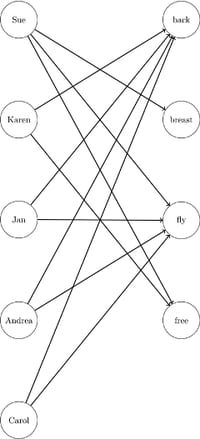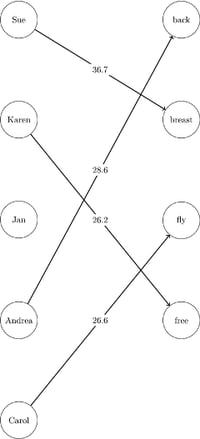The OPTNET Procedure
- Overview
-
Getting Started

-
Syntax
 Functional SummaryPROC OPTNET StatementBICONCOMP StatementCLIQUE StatementCONCOMP StatementCYCLE StatementDATA_ADJ_MATRIX_VAR StatementDATA_LINKS_VAR StatementDATA_MATRIX_VAR StatementDATA_NODES_VAR StatementLINEAR_ASSIGNMENT StatementMINCOSTFLOW StatementMINCUT StatementMINSPANTREE StatementSHORTPATH StatementTRANSITIVE_CLOSURE StatementTSP Statement
Functional SummaryPROC OPTNET StatementBICONCOMP StatementCLIQUE StatementCONCOMP StatementCYCLE StatementDATA_ADJ_MATRIX_VAR StatementDATA_LINKS_VAR StatementDATA_MATRIX_VAR StatementDATA_NODES_VAR StatementLINEAR_ASSIGNMENT StatementMINCOSTFLOW StatementMINCUT StatementMINSPANTREE StatementSHORTPATH StatementTRANSITIVE_CLOSURE StatementTSP Statement -
Details

-
Examples
 Articulation Points in a Terrorist NetworkCycle Detection for Kidney Donor ExchangeLinear Assignment Problem for Minimizing Swim TimesLinear Assignment Problem, Sparse Format versus Dense FormatMinimum Spanning Tree for Computer Network TopologyTransitive Closure for Identification of Circular Dependencies in a Bug Tracking SystemTraveling Salesman Tour through US Capital Cities
Articulation Points in a Terrorist NetworkCycle Detection for Kidney Donor ExchangeLinear Assignment Problem for Minimizing Swim TimesLinear Assignment Problem, Sparse Format versus Dense FormatMinimum Spanning Tree for Computer Network TopologyTransitive Closure for Identification of Circular Dependencies in a Bug Tracking SystemTraveling Salesman Tour through US Capital Cities - References
Example 2.4 Linear Assignment Problem, Sparse Format versus Dense Format
This example looks at the problem of assigning swimmers to strokes based on their best times. However, in this case certain swimmers are not eligible to perform certain strokes. A missing (.) value in the data matrix identifies an ineligible assignment. For example:
data RelayTimesMatrix; input name $ sex $ back breast fly free; datalines; Sue F . 36.7 28.3 36.1 Karen F 34.6 . . 26.2 Jan F 31.3 . 27.1 . Andrea F 28.6 . 29.1 . Carol F 32.9 . 26.6 . ;
Recall that the linear assignment problem can also be interpreted as the minimum-weight matching in a bipartite graph. The eligible assignments define links between the rows (swimmers) and the columns (strokes), as in Output 2.4.1.
Output 2.4.1: Bipartite Graph for Linear Assignment Problem

Because of this, you can represent the same data in RelayTimesMatrix with a links data set as follows:
data RelayTimesLinks; input name $ attr $ cost; datalines; Sue breast 36.7 Sue fly 28.3 Sue free 36.1 Karen back 34.6 Karen free 26.2 Jan back 31.3 Jan fly 27.1 Andrea back 28.6 Andrea fly 29.1 Carol back 32.9 Carol fly 26.6 ;
This graph must be bipartite (such that ![]() and
and ![]() are disjoint); if it is not, PROC OPTNET returns an error.
are disjoint); if it is not, PROC OPTNET returns an error.
Now, you can use either input format to solve the same problem as follows:
proc optnet
data_matrix = RelayTimesMatrix;
linear_assignment
out = LinearAssignMatrix
weight = (back--free)
id = (name sex);
run;
proc optnet
graph_direction = directed
data_links = RelayTimesLinks;
data_links_var
from = name
to = attr
weight = cost;
linear_assignment
out = LinearAssignLinks;
run;
When you use the graph input format, the LINEAR_ASSIGNMENT options WEIGHT= and ID= are not used directly.
The data sets LinearAssignMatrix and LinearAssignLinks now contain the optimal assignments, as shown in Output 2.4.2 and Output 2.4.3.
Output 2.4.2: Optimal Assignments for Swim Times (Dense Input)
| name | sex | assign | cost |
|---|---|---|---|
| Sue | F | breast | 36.7 |
| Karen | F | free | 26.2 |
| Andrea | F | back | 28.6 |
| Carol | F | fly | 26.6 |
| 118.1 |
Output 2.4.3: Optimal Assignments for Swim Times (Sparse Input)
| name | attr | cost |
|---|---|---|
| Sue | breast | 36.7 |
| Karen | free | 26.2 |
| Andrea | back | 28.6 |
| Carol | fly | 26.6 |
| 118.1 |
The optimal assignments are shown graphically in Output 2.4.4.
Output 2.4.4: Optimal Assignments for Swim Times

For large problems where a number of links are forbidden, the sparse format can be faster and can save a great deal of memory.
Consider an example that uses the format of the DATA_MATRIX= option with 15,000 columns (![]() ) and 4,000 rows (
) and 4,000 rows (![]() ). To store the dense matrix in memory, PROC OPTNET needs to allocate approximately
). To store the dense matrix in memory, PROC OPTNET needs to allocate approximately ![]() MB. If the data have mostly ineligible links, then the sparse (graph) format that uses the DATA_LINKS= option is much more
efficient with respect to memory. For example, if the data have only 5% of the eligible links (
MB. If the data have mostly ineligible links, then the sparse (graph) format that uses the DATA_LINKS= option is much more
efficient with respect to memory. For example, if the data have only 5% of the eligible links (![]() ), then the dense storage would still need 457 MB, while the sparse storage needs approximately
), then the dense storage would still need 457 MB, while the sparse storage needs approximately ![]() MB. If the problem is fully dense (all links are eligible), then the dense format that uses the DATA_MATRIX= option is the
most efficient.
MB. If the problem is fully dense (all links are eligible), then the dense format that uses the DATA_MATRIX= option is the
most efficient.